Themis Palpanas
MSAD: A Deep Dive into Model Selection for Time series Anomaly Detection
Oct 30, 2025Abstract:Anomaly detection is a fundamental task for time series analytics with important implications for the downstream performance of many applications. Despite increasing academic interest and the large number of methods proposed in the literature, recent benchmarks and evaluation studies demonstrated that no overall best anomaly detection methods exist when applied to very heterogeneous time series datasets. Therefore, the only scalable and viable solution to solve anomaly detection over very different time series collected from diverse domains is to propose a model selection method that will select, based on time series characteristics, the best anomaly detection methods to run. Existing AutoML solutions are, unfortunately, not directly applicable to time series anomaly detection, and no evaluation of time series-based approaches for model selection exists. Towards that direction, this paper studies the performance of time series classification methods used as model selection for anomaly detection. In total, we evaluate 234 model configurations derived from 16 base classifiers across more than 1980 time series, and we propose the first extensive experimental evaluation of time series classification as model selection for anomaly detection. Our results demonstrate that model selection methods outperform every single anomaly detection method while being in the same order of magnitude regarding execution time. This evaluation is the first step to demonstrate the accuracy and efficiency of time series classification algorithms for anomaly detection, and represents a strong baseline that can then be used to guide the model selection step in general AutoML pipelines. Preprint version of an article accepted at the VLDB Journal.
* 25 pages, 13 figures, VLDB Journal
Few Labels are all you need: A Weakly Supervised Framework for Appliance Localization in Smart-Meter Series
Jun 06, 2025Abstract:Improving smart grid system management is crucial in the fight against climate change, and enabling consumers to play an active role in this effort is a significant challenge for electricity suppliers. In this regard, millions of smart meters have been deployed worldwide in the last decade, recording the main electricity power consumed in individual households. This data produces valuable information that can help them reduce their electricity footprint; nevertheless, the collected signal aggregates the consumption of the different appliances running simultaneously in the house, making it difficult to apprehend. Non-Intrusive Load Monitoring (NILM) refers to the challenge of estimating the power consumption, pattern, or on/off state activation of individual appliances using the main smart meter signal. Recent methods proposed to tackle this task are based on a fully supervised deep-learning approach that requires both the aggregate signal and the ground truth of individual appliance power. However, such labels are expensive to collect and extremely scarce in practice, as they require conducting intrusive surveys in households to monitor each appliance. In this paper, we introduce CamAL, a weakly supervised approach for appliance pattern localization that only requires information on the presence of an appliance in a household to be trained. CamAL merges an ensemble of deep-learning classifiers combined with an explainable classification method to be able to localize appliance patterns. Our experimental evaluation, conducted on 4 real-world datasets, demonstrates that CamAL significantly outperforms existing weakly supervised baselines and that current SotA fully supervised NILM approaches require significantly more labels to reach CamAL performances. The source of our experiments is available at: https://github.com/adrienpetralia/CamAL. This paper appeared in ICDE 2025.
* 12 pages, 10 figures. This paper appeared in IEEE ICDE 2025
NILMFormer: Non-Intrusive Load Monitoring that Accounts for Non-Stationarity
Jun 06, 2025



Abstract:Millions of smart meters have been deployed worldwide, collecting the total power consumed by individual households. Based on these data, electricity suppliers offer their clients energy monitoring solutions to provide feedback on the consumption of their individual appliances. Historically, such estimates have relied on statistical methods that use coarse-grained total monthly consumption and static customer data, such as appliance ownership. Non-Intrusive Load Monitoring (NILM) is the problem of disaggregating a household's collected total power consumption to retrieve the consumed power for individual appliances. Current state-of-the-art (SotA) solutions for NILM are based on deep-learning (DL) and operate on subsequences of an entire household consumption reading. However, the non-stationary nature of real-world smart meter data leads to a drift in the data distribution within each segmented window, which significantly affects model performance. This paper introduces NILMFormer, a Transformer-based architecture that incorporates a new subsequence stationarization/de-stationarization scheme to mitigate the distribution drift and that uses a novel positional encoding that relies only on the subsequence's timestamp information. Experiments with 4 real-world datasets show that NILMFormer significantly outperforms the SotA approaches. Our solution has been deployed as the backbone algorithm for EDF's (Electricit\'e De France) consumption monitoring service, delivering detailed insights to millions of customers about their individual appliances' power consumption. This paper appeared in KDD 2025.
* 12 pages, 8 figures. This paper appeared in ACM SIGKDD 2025
DeviceScope: An Interactive App to Detect and Localize Appliance Patterns in Electricity Consumption Time Series
Jun 06, 2025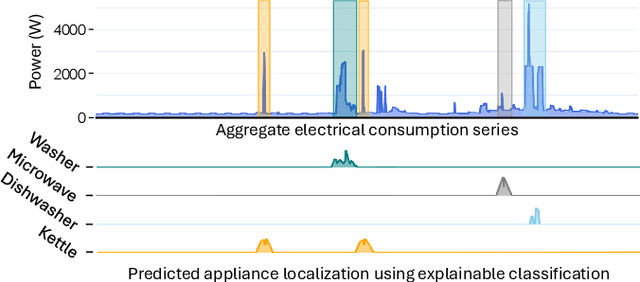
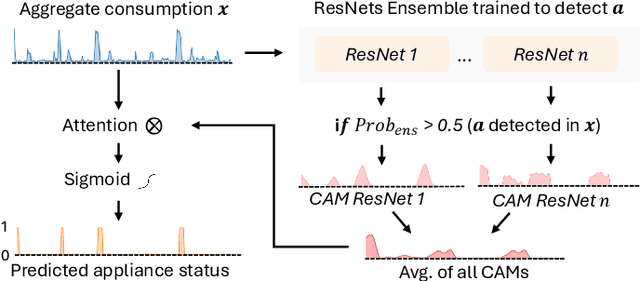
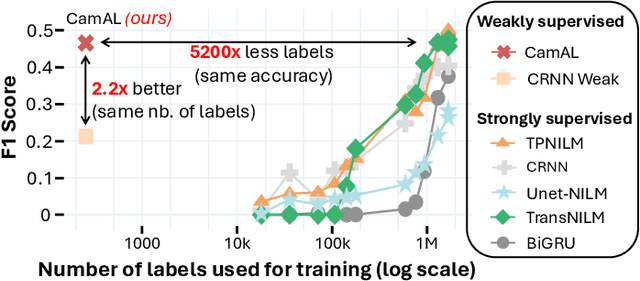
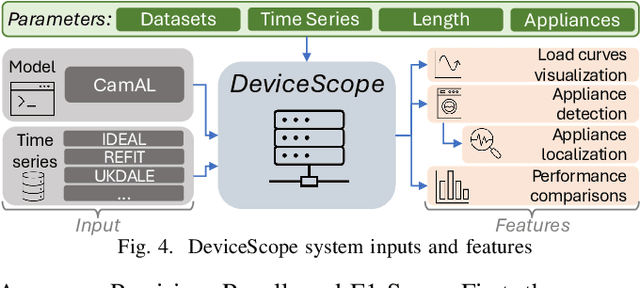
Abstract:In recent years, electricity suppliers have installed millions of smart meters worldwide to improve the management of the smart grid system. These meters collect a large amount of electrical consumption data to produce valuable information to help consumers reduce their electricity footprint. However, having non-expert users (e.g., consumers or sales advisors) understand these data and derive usage patterns for different appliances has become a significant challenge for electricity suppliers because these data record the aggregated behavior of all appliances. At the same time, ground-truth labels (which could train appliance detection and localization models) are expensive to collect and extremely scarce in practice. This paper introduces DeviceScope, an interactive tool designed to facilitate understanding smart meter data by detecting and localizing individual appliance patterns within a given time period. Our system is based on CamAL (Class Activation Map-based Appliance Localization), a novel weakly supervised approach for appliance localization that only requires the knowledge of the existence of an appliance in a household to be trained. This paper appeared in ICDE 2025.
* 4 pages, 5 figures. This paper appeared in ICDE 2025
LEAD: Iterative Data Selection for Efficient LLM Instruction Tuning
May 12, 2025Abstract:Instruction tuning has emerged as a critical paradigm for improving the capabilities and alignment of large language models (LLMs). However, existing iterative model-aware data selection methods incur significant computational overhead, as they rely on repeatedly performing full-dataset model inference to estimate sample utility for subsequent training iterations, creating a fundamental efficiency bottleneck. In this paper, we propose LEAD, an efficient iterative data selection framework that accurately estimates sample utility entirely within the standard training loop, eliminating the need for costly additional model inference. At its core, LEAD introduces Instance-Level Dynamic Uncertainty (IDU), a theoretically grounded utility function combining instantaneous training loss, gradient-based approximation of loss changes, and exponential smoothing of historical loss signals. To further scale efficiently to large datasets, LEAD employs a two-stage, coarse-to-fine selection strategy, adaptively prioritizing informative clusters through a multi-armed bandit mechanism, followed by precise fine-grained selection of high-utility samples using IDU. Extensive experiments across four diverse benchmarks show that LEAD significantly outperforms state-of-the-art methods, improving average model performance by 6.1%-10.8% while using only 2.5% of the training data and reducing overall training time by 5-10x.
Graphint: Graph-based Time Series Clustering Visualisation Tool
Mar 10, 2025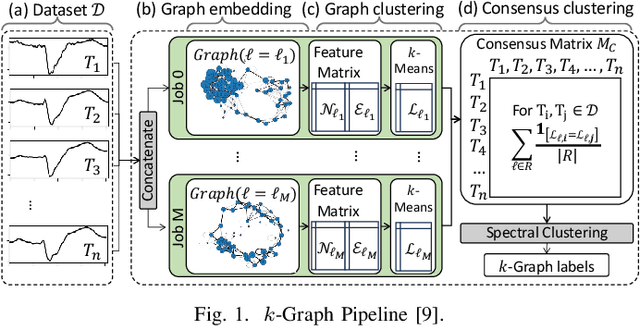
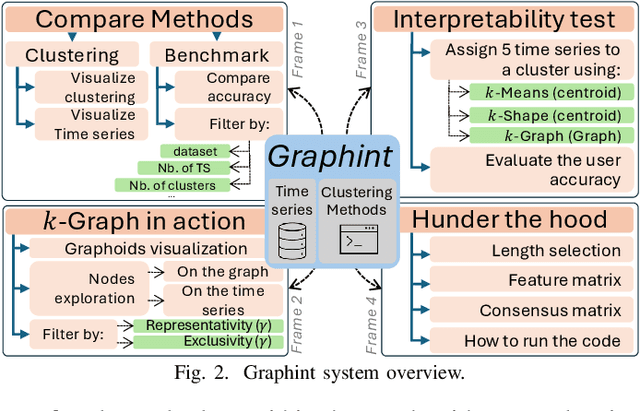
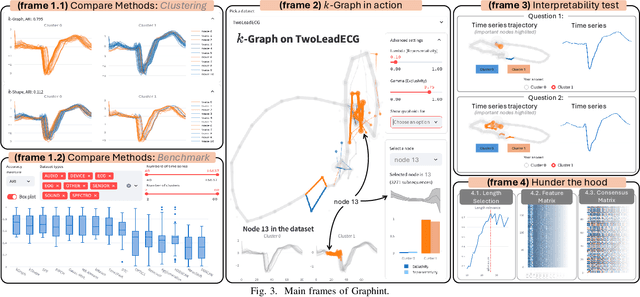
Abstract:With the exponential growth of time series data across diverse domains, there is a pressing need for effective analysis tools. Time series clustering is important for identifying patterns in these datasets. However, prevailing methods often encounter obstacles in maintaining data relationships and ensuring interpretability. We present Graphint, an innovative system based on the $k$-Graph methodology that addresses these challenges. Graphint integrates a robust time series clustering algorithm with an interactive tool for comparison and interpretation. More precisely, our system allows users to compare results against competing approaches, identify discriminative subsequences within specified datasets, and visualize the critical information utilized by $k$-Graph to generate outputs. Overall, Graphint offers a comprehensive solution for extracting actionable insights from complex temporal datasets.
VUS: Effective and Efficient Accuracy Measures for Time-Series Anomaly Detection
Feb 18, 2025



Abstract:Anomaly detection (AD) is a fundamental task for time-series analytics with important implications for the downstream performance of many applications. In contrast to other domains where AD mainly focuses on point-based anomalies (i.e., outliers in standalone observations), AD for time series is also concerned with range-based anomalies (i.e., outliers spanning multiple observations). Nevertheless, it is common to use traditional point-based information retrieval measures, such as Precision, Recall, and F-score, to assess the quality of methods by thresholding the anomaly score to mark each point as an anomaly or not. However, mapping discrete labels into continuous data introduces unavoidable shortcomings, complicating the evaluation of range-based anomalies. Notably, the choice of evaluation measure may significantly bias the experimental outcome. Despite over six decades of attention, there has never been a large-scale systematic quantitative and qualitative analysis of time-series AD evaluation measures. This paper extensively evaluates quality measures for time-series AD to assess their robustness under noise, misalignments, and different anomaly cardinality ratios. Our results indicate that measures producing quality values independently of a threshold (i.e., AUC-ROC and AUC-PR) are more suitable for time-series AD. Motivated by this observation, we first extend the AUC-based measures to account for range-based anomalies. Then, we introduce a new family of parameter-free and threshold-independent measures, Volume Under the Surface (VUS), to evaluate methods while varying parameters. We also introduce two optimized implementations for VUS that reduce significantly the execution time of the initial implementation. Our findings demonstrate that our four measures are significantly more robust in assessing the quality of time-series AD methods.
$k$-Graph: A Graph Embedding for Interpretable Time Series Clustering
Feb 18, 2025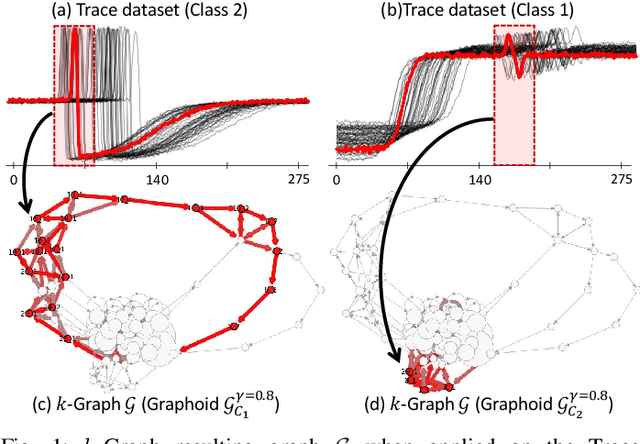


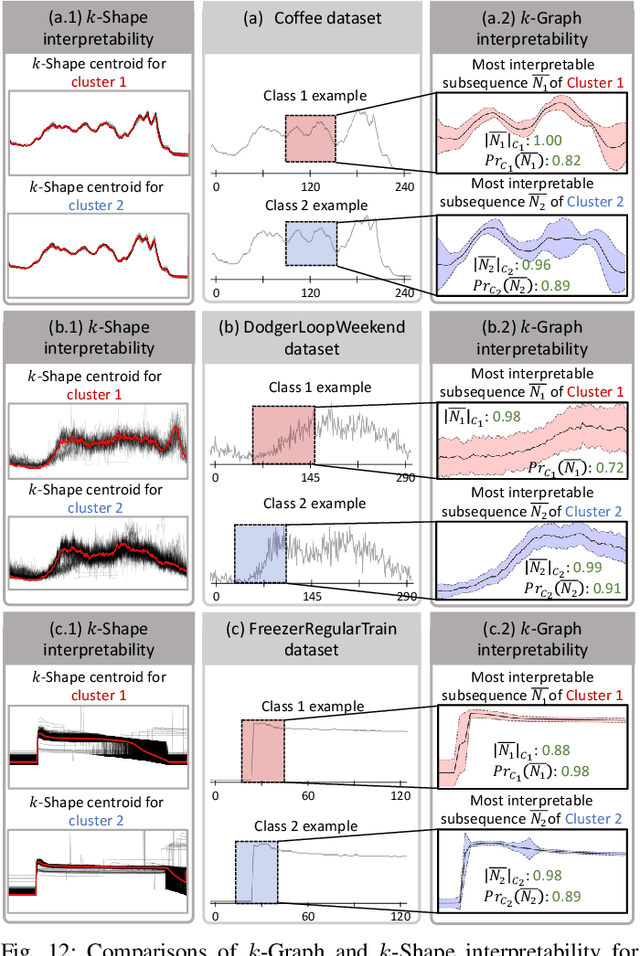
Abstract:Time series clustering poses a significant challenge with diverse applications across domains. A prominent drawback of existing solutions lies in their limited interpretability, often confined to presenting users with centroids. In addressing this gap, our work presents $k$-Graph, an unsupervised method explicitly crafted to augment interpretability in time series clustering. Leveraging a graph representation of time series subsequences, $k$-Graph constructs multiple graph representations based on different subsequence lengths. This feature accommodates variable-length time series without requiring users to predetermine subsequence lengths. Our experimental results reveal that $k$-Graph outperforms current state-of-the-art time series clustering algorithms in accuracy, while providing users with meaningful explanations and interpretations of the clustering outcomes.
Graph-Based Vector Search: An Experimental Evaluation of the State-of-the-Art
Feb 08, 2025



Abstract:Vector data is prevalent across business and scientific applications, and its popularity is growing with the proliferation of learned embeddings. Vector data collections often reach billions of vectors with thousands of dimensions, thus, increasing the complexity of their analysis. Vector search is the backbone of many critical analytical tasks, and graph-based methods have become the best choice for analytical tasks that do not require guarantees on the quality of the answers. We briefly survey in-memory graph-based vector search, outline the chronology of the different methods and classify them according to five main design paradigms: seed selection, incremental insertion, neighborhood propagation, neighborhood diversification, and divide-and-conquer. We conduct an exhaustive experimental evaluation of twelve state-of-the-art methods on seven real data collections, with sizes up to 1 billion vectors. We share key insights about the strengths and limitations of these methods; e.g., the best approaches are typically based on incremental insertion and neighborhood diversification, and the choice of the base graph can hurt scalability. Finally, we discuss open research directions, such as the importance of devising more sophisticated data-adaptive seed selection and diversification strategies.
Dive into Time-Series Anomaly Detection: A Decade Review
Dec 29, 2024Abstract:Recent advances in data collection technology, accompanied by the ever-rising volume and velocity of streaming data, underscore the vital need for time series analytics. In this regard, time-series anomaly detection has been an important activity, entailing various applications in fields such as cyber security, financial markets, law enforcement, and health care. While traditional literature on anomaly detection is centered on statistical measures, the increasing number of machine learning algorithms in recent years call for a structured, general characterization of the research methods for time-series anomaly detection. This survey groups and summarizes anomaly detection existing solutions under a process-centric taxonomy in the time series context. In addition to giving an original categorization of anomaly detection methods, we also perform a meta-analysis of the literature and outline general trends in time-series anomaly detection research.
 Add to Chrome
Add to Chrome Add to Firefox
Add to Firefox Add to Edge
Add to Edge